Notes of Progress- My Journey Through Piano and Music Theory
Years ago, when I picked up my guitar for the first time, I just wanted to play music. I was captivated by the beautiful tabs on YouTube. I just wanted to play strum the strings and make ting ting ting. The thought of learning concepts like scales and triads escaped me, as if they were some kind of mystical knowledge beyond my reach, why do I even need those? (And I was so wrong. Big mistake).
Years later, when I bought my piano, I decided it was time to dive deep—to truly understand music and how it works. How all those notes, lines, and squiggles come together to create something heartachingly beautiful. And thus, my journey begins.
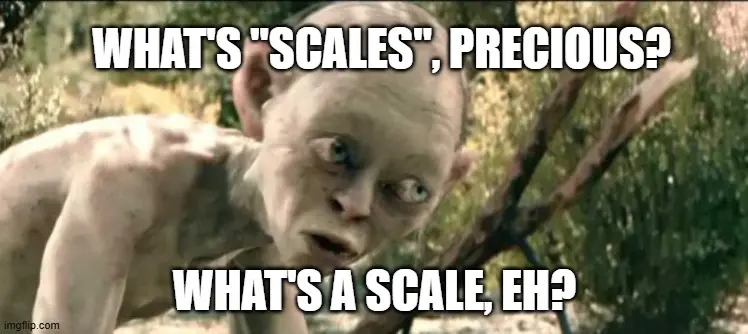
Learning the Keys#
I took a subscription of Playground Sessions, a piano learning app. Connecting my piano with the app using MIDI cable, it was really helpful to learn with instant feedback and a structured approach. First came the keys, 88 in total, in my full-sized keyboard - Kawaii ES120
There are are repeated pattern 3 white, 2 black and 4 white, 3 black. I divided this two groupings. With his 2 black and 3 black, it was easier to visualize the pattern.
The notes in the first grouping three white keys are C,D,E.
The second grouping four white keys are F,G,A,B.
The black keys are called accidentals, we will come back to them later.
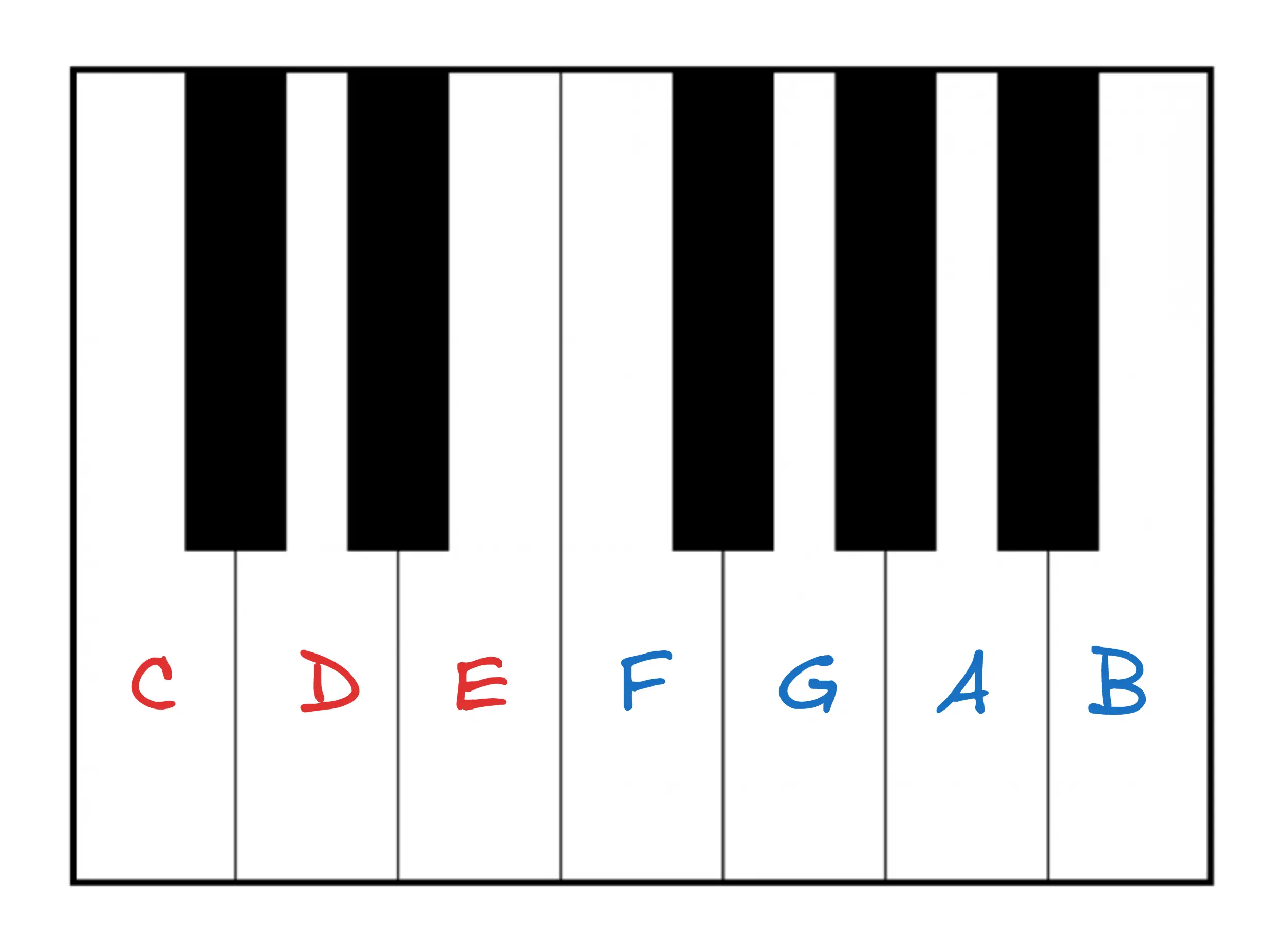
Reading Music#
Reading music, all those beautiful lines, notes, and squiggles. How do I read them? Watching pianist playing the piano, they seem to read the music as easily as I read this article. Just like reading english, it's all about the notes and the pattern, then keep on building combining those into elaborate pieces. In youtube, lots of the tutorials are using something called "synthesia", where the notes fall on the keys as the artist plays the piano. However, this is not the best way to learn. It's rote learning, not understanding.
Now, coming to back reading music, it's language. In piano, we play with both hands. from the left to right, the notes get higher pitched.
A Musical Staff is divided into 2 sections, the top is the treble clef, and the bottom is the bass clef.
Right hand plays the treble clef, and left hand plays the bass clef.
In the middle, we have the middle C, which divides the layout.
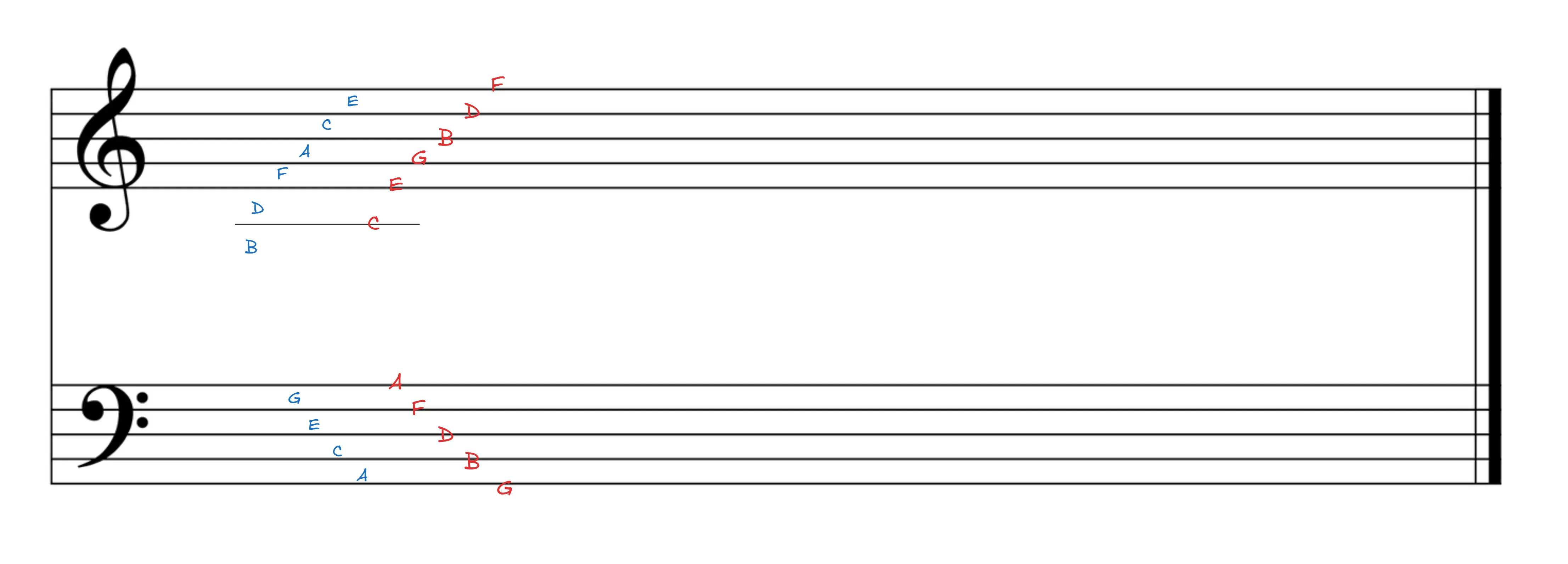
On each clef section, there are 5 horizontal lines and 4 spaces. and middle C takes up the pseudo-middle line. the spaces directly on above and below the middle C are called D and B respectively.
Each of this lines and space has a name, in treble clef starting from the bottom line, the names are E,G,B,D,F. and the spaces are F,A,C,E.
In bass clef, starting from the bottom line, the names are G,B,D,F,A. and the spaces are A,C,E,G.
To memorize this notes, there are usual mnemonics, for example, E,G,B,D,F can be memorized as Every Good Boy Does Fine.
However, I decided to learn it by heart. Practicing everyday, writing the notes names on empty staff. It helped me to memorize the notes. To get random access to notes, instead of going over each notes. In software engineering terms, O(1) time complexity vs O(n) time complexity.
Time signature and counting#
Next comes the time signature. Intuitively, humans can feel the the music. It's how we feel the rhythm and dance. The Beat, where we snap our fingers.
A measure a segment of time in a piece of music, defined by a specific number of beats.
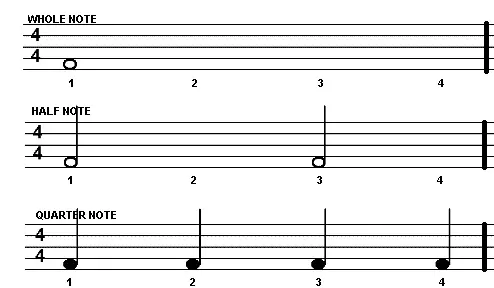
Let's start with 4/4 time signature. The top number 4 tells us that there are 4 beats in a measure. The bottom number 4 tells us that each beat is a quarter note.
One (strong), Two (weak), Three (medium), Four (weak) - One (strong), Two (weak), Three (medium), Four (weak)
Similarly, 4/2 time signature has 4 beats in a measure, and but each beat is a half note. The music feels the same rhythm but slower. As each beat plays for a longer amount
Oneeee, Twooooo, Threeeee, Fourrrrr,
3/4 time signature has 3 beats in a measure, and each beat is a quarter note.
One (strong), Two (medium), Three (weak) - One (strong), Two (medium), Three (weak) - One (strong), Two (medium), Three (weak)
We can think of a note as a unit of time. A whole note (semibreve) takes 4 beats, a half note (minim) takes 2 beats, a quarter note (crotchet) takes 1 beat, and an eighth note (quaver) takes 0.5 beat and so on.
A rest implies, where we don't play anything.
Similarly, a whole rest (semibreve rest) takes 4 beats of silence, a half rest (minim rest) takes 2 beats of silence, a quarter rest (crotchet rest) takes 1 beat of silence, and an eighth rest (quaver rest) takes 0.5 beat of silence and so on.
A whole rest is marked as a rectangle underneath the staff lines. A half rest is marked as a rectangle above the staff lines.
Ties are used to connect two notes of the same value.
Dots are used to increase the duration of a note by half of its value. So, a dotted half note in 4/4 time signature takes 2 beats (half of 4 beats) + 1 beat (half of 2 beats) = 3 beats.
Key signatures and accidentals#
The black keys are called accidentals. They are called either sharp (#) or flat (b), depending on the key signature.
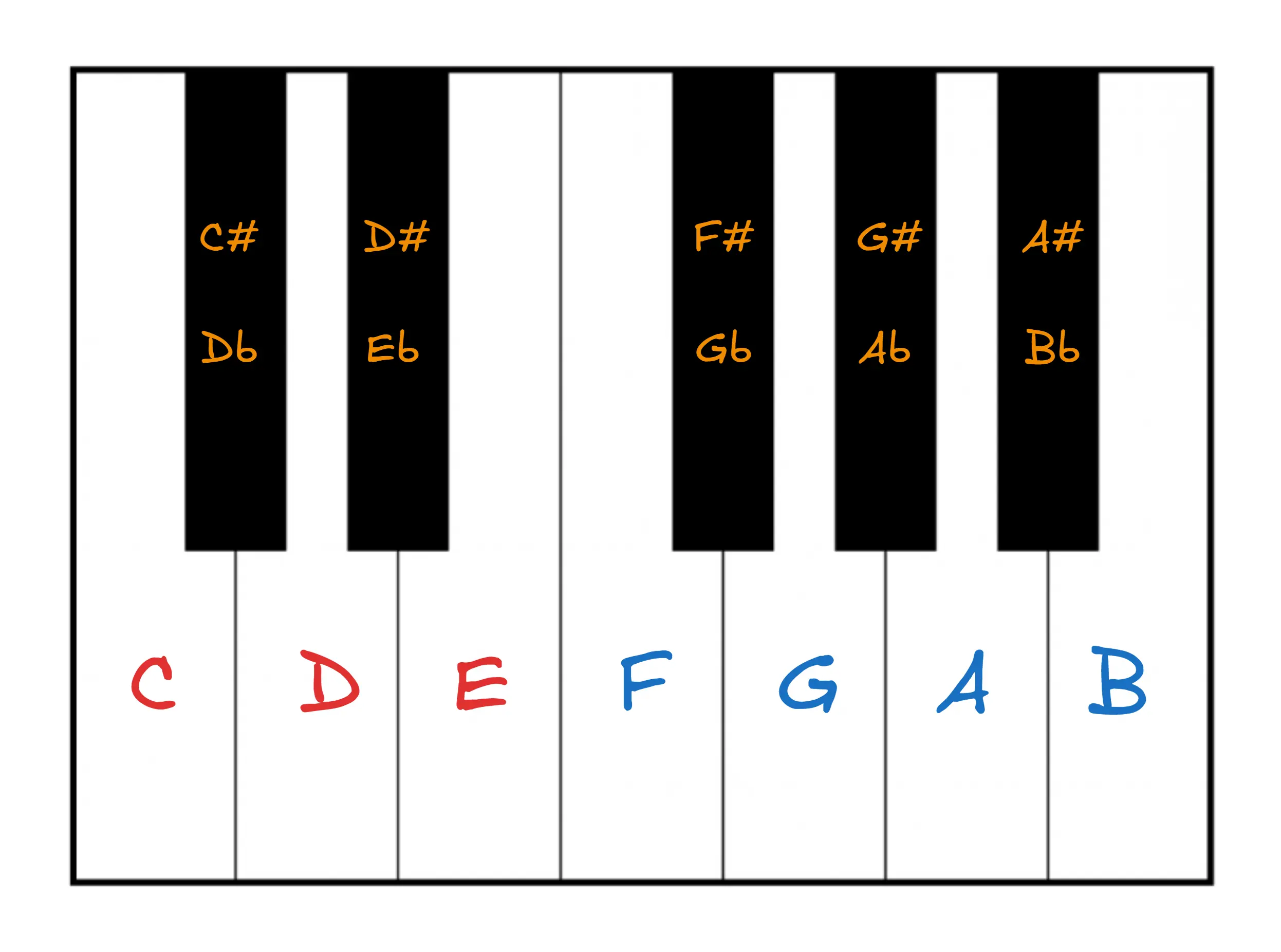
The Key Signature tells us which notes in a piece are naturally sharp (♯) or flat (♭) throughout the music.
For example, in C major and it's relative minor Am, there are no sharps or flats, we play only white keys.
Every major key has a relative minor, which uses the same notes but has a different tonal center (tonic/root note).
For example, to Find the relative minor of C major, we count 6th note of the major scale of C.
C major scale: C, D, E, F, G, A, B
The 6th note is A, so the relative minor of C major is A minor.
Simillarly, G major - Em etc.
A key signautre automatically adds the accidentals to the note of that key signautre throughout the music. Unless there is a natural sign.
For example, in G Major, the key signature has an F♯. That means every F in the piece is automatically F♯, unless an accidental (like ♮ or ♭) changes it temporarily.
Intervals, Scales#
Distance between notes are measured in semitones (half steps) and whole tones (whole steps).
A semitone / half step is the smallest interval in music, representing a half step in pitch. It is the distance between two adjacent keys on a piano keyboard (either white or black).
For example, C → C# (1 semitone) → D (1 semitone)
A whole tone / whole step is the distance between two notes that are two semitones apart.
For example, C → D (2 semitones) (C → C# (1 semitone) → D (1 semitone))
A scale is a a pattern of sequence of notes that are played one after the other.
A scale contains 7 notes, and the 8th note is the same as the 1st note. This is called the octave.
Major Scale
The structure of Major scale is Tonic−W−W−H−W−W−W−H
Where Tonic is the root note, W is whole tone, and H is half tone.
For example, C major scale is C(tonic)−D(W)−E(W)−F(H)−G(W)−A(W)−B(W)−C(H)
Minor Scale
The structure of Minor scale is Tonic−W−H−W−W−H−W−W
For example, A minor scale is A(tonic)−B(W)−C(H)−D(W)−E(W)−F(H)−G(W)−A(W)
Degree: refers to the position of a note within a scale. Each scale has seven degrees, which are numbered 1 to 7 (or written as I to VII in Roman numerals).
For example, degrees of C major scale are C(1)−D(2)−E(3)−F(4)−G(5)−A(6)−B(7)−C(8)
Chords: Major and Minor#
A chord is a group of 3 or more notes played together.
A chord built with 3 notes is called a Triad.
Major Chords
are generally associated with Happy, Bright emotions.
To build a major chord in any key, we do,
Root + Major Third (4 half steps) + Perfect Fifth (3 half steps)
For example, C major chord is C + E + G
Minor Chords
are generally associated with Sad, Mysterious emotions.
To build a minor chord in any key, we do,
Root + Minor Third (3 half steps) + Perfect Fifth (4 half steps)
For example, A minor chord is A + C + E
Each scale has a set of triads built on each degree (note) of the scale. These triads are formed by stacking thirds on top of each scale degree
For example, C major scale has C major, D minor, E minor, F major, G major, A minor, B diminished triads.
Triads in the C Major Scale
| Chord Number | Root | Triad Notes | Chord Type |
|---|---|---|---|
| I (1st) | C | C - E - G | C Major |
| ii (2nd) | D | D - F - A | D Minor |
| iii (3rd) | E | E - G - B | E Minor |
| IV (4th) | F | F - A - C | F Major |
| V (5th) | G | G - B - D | G Major |
| vi (6th) | A | A - C - E | A Minor |
| vii° (7th) | B | B - D - F | B Diminished |
Major chords: C, F, G (I, IV, V)
Minor chords: Dm, Em, Am (ii, iii, vi)
The Third Determines Whether a Chord is Major or Minor
In a major scale, the third note is a major third.
In a minor scale, the third note is a minor third.
The perfect fifth (7 semitones) adds stability but doesn't affect the major/minor quality
In Any natural Major Scale, I, IV, and V will always be major chords and ii, iii, and vi will always be minor chords
Triads in the Am Scale
| Degree | Chord | Notes | Chord Type |
|---|---|---|---|
| i | A Minor | A - C - E | Minor Chord |
| ii° | B Diminished | B - D - F | Diminished Chord |
| III | C Major | C - E - G | Major Chord |
| iv | D Minor | D - F - A | Minor Chord |
| v | E Minor | E - G - B | Minor Chord |
| VI | F Major | F - A - C | Major Chord |
| VII | G Major | G - B - D | Major Chord |
Major chords: C, F, G (I, IV, V)
Minor chords: Dm, Em, Am (ii, iii, vi)
In Any natural Minor Scale, i, iv, and v will always be minor chords and iii, vi, and vii will always be major chords and The ii° chord is always diminished.
Universal Triad pattern table for both Major and Minor scales
| Degree | Major Scale Triad | Chord Type | Intervals from Root (Half Steps) | Minor Scale Triad | Chord Type | Intervals from Root (Half Steps) |
|---|---|---|---|---|---|---|
| I / i | Major | Major Chord | Root → Major 3rd (4H) → Perfect 5th (7H) | Minor | Minor Chord | Root → Minor 3rd (3H) → Perfect 5th (7H) |
| ii / ii° | Minor | Minor Chord | Root → Minor 3rd (3H) → Perfect 5th (7H) | Diminished | Diminished Chord | Root → Minor 3rd (3H) → Diminished 5th (6H) |
| iii / III | Minor | Minor Chord | Root → Minor 3rd (3H) → Perfect 5th (7H) | Major | Major Chord | Root → Major 3rd (4H) → Perfect 5th (7H) |
| IV / iv | Major | Major Chord | Root → Major 3rd (4H) → Perfect 5th (7H) | Minor | Minor Chord | Root → Minor 3rd (3H) → Perfect 5th (7H) |
| V / v | Major | Major Chord | Root → Major 3rd (4H) → Perfect 5th (7H) | Minor | Minor Chord | Root → Minor 3rd (3H) → Perfect 5th (7H) |
| vi / VI | Minor | Minor Chord | Root → Minor 3rd (3H) → Perfect 5th (7H) | Major | Major Chord | Root → Major 3rd (4H) → Perfect 5th (7H) |
| vii° / VII | Diminished | Diminished Chord | Root → Minor 3rd (3H) → Diminished 5th (6H) | Major | Major Chord | Root → Major 3rd (4H) → Perfect 5th (7H) |
Chord Inversions: Root position, 1st inversion, 2nd inversion#
When we play a chord, we can play it in different positions. Chord inversions change the order of notes in a chord without changing the chord itself. It helps in smoother transitions, bass movement, and different emotional effects in music.
Root Position: The root note is the lowest note in the chord. (Root = lowest note)
1st Inversion: The root note is the second lowest note in the chord. (Third = lowest note)
2nd Inversion: The root note is the third lowest note in the chord. (Fifth = lowest note)
For example, C major chord in root position is C + E + G
C major chord in 1st inversion is E + G + C . the lowest note C was moved an octave higher. E is the lowest note.
C major chord in 2nd inversion is G + C + E . Again, the lowest note E was shifted an octave higher. G is the lowest note.
